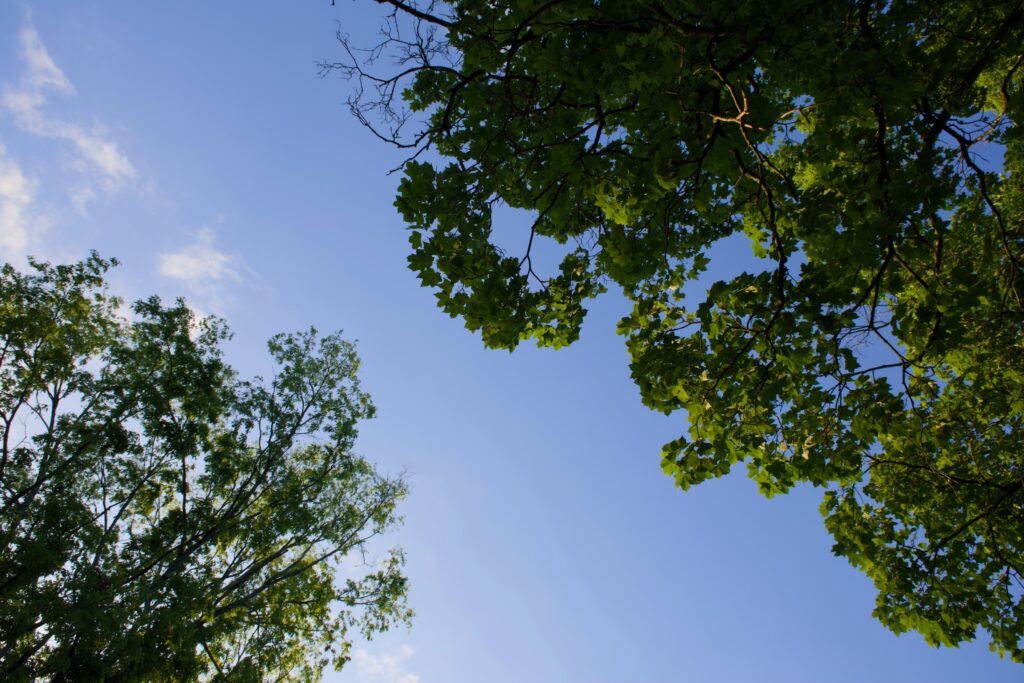
Nashville may have the largest urban tree canopy among major U.S. cities.
In December, the city published its first comprehensive urban tree canopy assessment measuring our trees — and tree loss — over an 11-year period.
Trees support all life on Earth, inhaling carbon dioxide and exhaling oxygen. For Nashville, as the planet warms, trees will be increasingly critical to reduce flooding, humidity and heat.
The new study found that Nashville’s urban tree canopy covers 53-56% of its land, rivaling the most forested cities in the nation.
“We need that measurement to tell us what’s happening. We need that accountability,” said Ginger Hausser, director of the Nashville Tree Conservation Corps. “Now we have that baseline moving forward.”
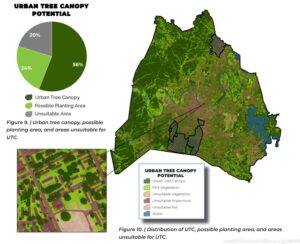 Courtesy Metro Nashville
Courtesy Metro Nashville In 2021, Nashville’s urban tree canopy covered 56% of its total land.
Excepting towns with small populations, like the massive Sitka, AK, Nashville has the largest urban tree canopy of major cities by area. The city may also have the largest canopy for populous cities by percentage.
Tree-famous cities like Atlanta, Austin, Portland and Raleigh have 47%, 41%, 30% and 50%, respectively. Studies in other cities could have been conducted differently, however — without a standardized assessment method, there are limitations in comparing city canopies.
Nashville’s tree canopy is not evenly distributed, and the city is geographically vast. Meaning that most people in town aren’t living with dense canopies.
Nashville is one of the largest cities by land area
Metro Nashville has about 320,000 acres of land, which equates to about 500 square miles, making it one of the largest U.S. cities by size. The city population is about 700,000.
The study documents nearly 170,000 acres of urban tree canopy. That figure translates to 53% or 56% of urban tree canopy cover, depending on whether water is included in the total area.
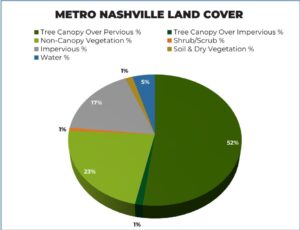 Courtesy Metro Nashville
Courtesy Metro Nashville Including water in the total land area, Metro Nashville’s urban tree canopy is 53%. Excluding water, the canopy represents 56% of city land.
The overwhelming majority of this canopy is in the rural and suburban areas, with the densest forests lining the western, hilly edge of the city — an area some local groups have named the “Highland Rim Forest.”
“The study shows we still have areas with good canopy within the city,” said Rebecca Dohn, who helped manage the study as Metro Water Services’ stormwater sustainability coordinator.
Given Nashville’s vast size, Dohn recommended comparing Nashville to other cities by looking at the canopy cover in the urban district, which is 39%.
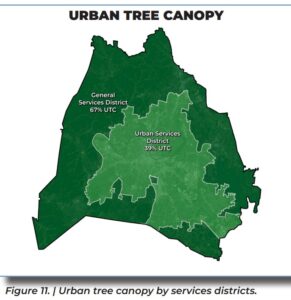 Courtesy Metro Nashville
Courtesy Metro Nashville Nashville’s urban tree canopy is concentrated in its rural, hilly areas.
Nashville’s tree canopy is changing
To create a comprehensive assessment, the study reviewed urban tree canopy and possible planting areas using aerial imagery and LiDAR. The city looked at trees, defined as greenery at least 10 feet tall, in the years 2010, 2016 and 2021.
In the first half of the study, Nashville expanded its tree canopy. This growth can likely be attributed primarily to existing forests extending their borders naturally and vegetative areas transitioning to woods — in the least dense regions of the city.
“Canopy gains are happening in rural areas like Joelton,” Dohn said, who added that parks like Shelby Bottoms had some vegetative areas transitioning to canopy. (The study also has a footnote that the imaging tools improved between the years 2010 and 2021, which could account for some of the canopy growth.)
In the second half of the study, from 2016 to 2021, the trend reversed: Nashville lost about 2,500 acres of trees, primarily in densely populated areas.
“We’re starting to decline,” Dohn said.
How to understand Nashville’s tree loss
Tree loss came from development, severe weather events like the 2020 tornado, hydrological shifts, pests and diseases. Climate change affects many of these factors.
One way to visualize Nashville’s tree canopy and tree loss is by transects.
Nashville is divided into seven main transects: rural, suburban, natural, district, urban, center and downtown. The rural and suburban transects account for 87% of Nashville’s urban tree canopy.
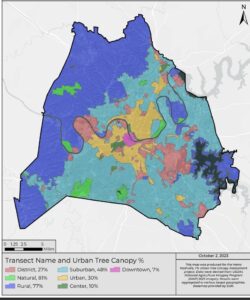 Courtesy Metro Nashville
Courtesy Metro Nashville Nashville is divided into seven main transects.
In the 2016-2021 period, three transects lost significant tree acreage. The suburban transect lost about 1,500 acres, the urban transect lost 678 acres, and the district transect lost nearly 450 acres. The natural, center and downtown transects remained about the same, and the rural transect gained about 1,600 acres.
The urban transect lost a total of 869 acres between 2010 and 2021, representing a relative change of 10%. This part of town went from about 8,750 acres in 2010 to 7,880 in 2021.
Note: Data for local divisions, like transects and community planning areas, covers Davidson County, which includes satellite cities like Belle Meade. Davidson County is about 336,000 acres and has about 180,000 acres of urban tree canopy.
Tree loss by neighborhoods
Nashville is also divided into 14 large neighborhoods: Downtown, East Nashville, South Nashville, North Nashville, West Nashville, Madison, Donelson-Hermitage-Old Hickory, Antioch-Priest Lake, Southeast, Green Hills-Midtown, Parkwood-Union Hill, Bordeaux-Whites Creek-Haynes Trinity, Bellevue and Joelton.
Between 2016 and 2021, six of these neighborhoods had significant tree loss. The Green Hills-Midtown area lost the most, at 712 acres. The other losses were 625 acres in Antioch-Priest, 362 acres in Donelson-Hermitage-Old Hickory, 358 acres in Madison, 298 acres in Southeast, and 136 acres in North Nashville. East Nashville also had a loss of about 6 acres.
The Green Hills-Midtown and West Nashville neighborhood losses were equivalent to 5% of their canopies. In North Nashville, the loss represented 14% of its canopy.
More: With fewer trees and more concrete, Nashville is heating up. What’s the plan? | WPLN News
 Courtesy Metro Nashville
Courtesy Metro Nashville Nashville has 14 community planning areas.
The other areas stayed roughly the same or had gains — Joelton had the largest gain of 624 acres, roughly a 3% increase. (Joelton, along with Parkwood-Union Hill, Bordeaux-Whites Creek-Haynes Trinity and Bellevue, have 55% of the city’s total canopy.)
Many of the other areas lack sufficient canopy, according to the city.
“Nine of our 14 community areas are not meeting their canopy goals,” Dohn said.
In 2021, downtown had the lowest canopy cover, at just 8%, followed by North Nashville, South Nashville and East Nashville, which had 21%, 27% and 41%, respectively.
Potential solutions and opportunities for tree plantings
The study also found that all of the neighborhoods measured have land that could be forested, with an average of 23% of land available for planting per neighborhood. Madison had the highest amount, at 30%, and downtown had the lowest, at 11%. If utilized, Madison could increase its total canopy cover up to 72% of its land. Downtown could more than double its canopy cover, increasing from 8% to 19%.
Nashville has a tree planting campaign, called Root Nashville, to plant 500,000 trees by 2050. The campaign began in 2018 and has reached about 9% of that goal so far.
This will not be sufficient planting to increase the city’s canopy, however, as Nashville is expected to lose 1.6 million trees from emerald ash borer damage alone.
“If we’re losing more trees than we’re planting, there is no way we’re not going to have a net loss,” Dohn said. “At this point, we’re trying to mitigate some of those losses.”
Another big solution could be stronger ordinances to protect existing canopy. The Nashville Tree Conservation Corps is involved in the process of drafting new legislation now.
Ginger Hausser, the organization’s director, encourages people to reach out and offer ideas.
“We’re really in a listening mode around these priorities,” she said, but added that one thing is clear. “We all want to live in a place that is green and beautiful.”
Nashville’s next urban tree canopy assessment is due by 2028.

